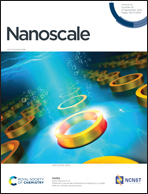In silico design of single transition metal atom anchored defective boron carbide monolayers as high-performance electrocatalysts for the nitrogen reduction reaction†
Abstract
Development of low-cost and high-efficiency single atom catalysts (SACs) is essential for catalyzing nitrogen reduction reactions (NRR) under ambient conditions. Current SACs suffer from low selectivity and poor activity, making it hard for them to meet the requirements of industrial applications. Here, we present a graphene-like BC3 monolayer as a substrate for single metal atoms. The catalytic performance of 4d and 5d metal atoms anchored in a vacancy containing BC3 monolayer for NRR is systematically investigated by first-principles calculations. We find that Re@VB is outstanding among all candidates, exhibiting high catalytic activity and selectivity, with a low limiting potential of −0.28 V. A new descriptor involving the active site and its environment is proposed, which has a volcano relationship with several factors in the catalytic process, establishing a link between the intrinsic properties of the active site and the catalytic performance. This study opens a new route to designing efficient catalysts with BC3 as a substrate.



 Please wait while we load your content...
Please wait while we load your content...